How computational chemistry could usher in a sustainable future
Extracting carbon dioxide from the atmosphere and turning it into something useful could be a key tool for tackling climate change, but the chemical reactions involved are not straightforward. Professor John Keith, of the University of Pittsburgh in the US, is investigating ways of making these reactions practical, by using advanced computer modelling to simulate the behaviour of catalysts
TALK LIKE A COMPUTATIONAL CHEMIST
CATALYST – a substance that increases the rate of a chemical reaction without permanently changing itself. Catalysts participate in reactions (they increase rates) and they also decompose over long timescales.
CHEMICAL ENGINEERING – a branch of engineering that investigates industrial chemical reactions and operations
COMPUTATIONAL CHEMISTRY – a branch of chemistry that uses computer modelling to solve chemical problems
ELECTROCATALYST – a catalyst that specifically participates in electrochemical reactions
ENTHALPY – an energy quantity equivalent to the total heat content of a system
ENTROPY – the degree of disorder in a system (when multiplied with the system temperature, it is the remainder of the energy available to do work)
ENZYME – a catalyst produced by a living organism to facilitate a biochemical reaction
HYDRIDE TRANSFER – the migration of one hydrogen atom with an extra electron from one atom to another
MOLECULAR DYNAMICS – a computational modelling method that analyses random movements of atoms and molecules
QUANTUM MECHANICS – a branch of mechanics that involves the mathematic characteristics of subatomic particles and their energies
Humanity’s reliance on fossil fuels over the past century has had a profound impact on the planet’s climate. Mitigating climate change is a key global challenge, and one part of the puzzle could be to recycle carbon dioxide from the atmosphere back into something useful. However, there are issues with this. Burning fuels such as natural gas releases energy (alongside carbon dioxide), but producing a fuel from carbon dioxide requires significant input of energy. “Some scientists are attempting this by channelling heat energy from solar power reactors, but this requires extremely high temperatures that can be hard to work with,” says Professor John Keith, an expert in computational chemistry and chemical engineering at the University of Pittsburgh. “Others are using electrical current to activate the reaction, but these processes use far more energy than is ultimately stored in the fuel.”
The key to solving this puzzle is finding a good catalyst – a substance that lowers the activation energy of a chemical reaction – so that the reaction happens more efficiently and under less extreme conditions. We use catalysts all the time, both in everyday life and industrial processes, but the right catalyst for large-scale conversion of carbon dioxide remains elusive.
HOW COMPUTATIONAL CHEMISTRY CAN HELP
“Computational chemistry is a way of calculating the energy within any system of atoms by modelling quantum mechanics on a computer,” says John. “It’s like a special kind of movie camera. We use computational chemistry as a ‘camera’ to take snapshots of important points along a reaction path of a known catalyst, and each snapshot contains the energy at those points. We can then take snapshots at the same points for any new theoretical catalyst and see if energies indicate that it should perform better.”
There are two benefits to using computational chemistry for this process. Firstly, the models may not be perfect, but they provide useful comparisons of catalysts that can help uncover how they function and give insights into what more effective catalysts might look like. Secondly, it is usually much simpler and cheaper to model catalysts on a computer as opposed to making them and performing experiments in the real world. Computer modelling has a rapidly growing role to play in uncovering catalysts for sustainable processes.
BEHIND THE MODELS
John’s computer models explain how much energy a particular system of atoms has. The chemical energy of any system (i.e. the ‘Gibbs free energy’) consists of two components: energy due to stored heat (enthalpy, which is modelled well with quantum mechanics) and energy due to disorder (entropy, which is modelled well using molecular dynamics). Understanding either is challenging in its own right, but most chemical problems can usually be approximated by focusing on one approach and cutting corners on the other. “Catalysis can get very complicated though, and sometimes we need to focus on both enthalpies and entropies, and that makes for challenging computer simulations,” says John.
Computational simulations bring other challenges too. “For starters, we never really know if and when our models are correct, so it’s important that we work with scientists doing real-life experiments and share knowledge,” says John. “Additionally, the more complicated the system, the more powerful the computer we need. We are sometimes limited in what we can study by the resources we have available.”
NOVEL ELECTROCATALYSTS
John works specifically with electrocatalysts, which are catalysts used for electrochemical reactions. The electrocatalysts he studies have quite a unique feature. “Conventional electrocatalysis usually occurs with one proton transfer or electron transfer at a time,” says John. “However, in nature we often see enzymes (biological catalysts) transferring one proton with two electrons all at once in a process called a hydride transfer.”
Despite hydride transfers being very common in biology and some areas of chemistry, they are uncommon in electrocatalysis. John’s work involves deciphering how to make these electrocatalysts switch from conventional electrochemical steps to hydride transfer steps, which could make electrochemical processes more efficient.
LOOKING FORWARDS
“We now have a much better idea about how to model conventional and unconventional reaction pathways,” says John. The data that John and his team have collected so far suggests that persuading electrocatalysts to switch to hydride transfer modes is possible, but it might not be as easy as originally hoped. That is the nature of scientific research, and John, tenacious as a scientist needs to be, is confident that the methods developed and lessons learned from fundamental research will have far reaching applications in the future.
Reference
https://doi.org/10.33424/FUTURUM109
John and his sons doing science experiments in the kitchen.
Artwork Reproduced from: Y. Basdogan and J. A. Keith, Chem. Sci., 2018, 9, 5341
DOI: 10.1039/ C8SC01424H, Published by The Royal Society of Chemistry.
CATALYST – a substance that increases the rate of a chemical reaction without permanently changing itself. Catalysts participate in reactions (they increase rates) and they also decompose over long timescales.
CHEMICAL ENGINEERING – a branch of engineering that investigates industrial chemical reactions and operations
COMPUTATIONAL CHEMISTRY – a branch of chemistry that uses computer modelling to solve chemical problems
ELECTROCATALYST – a catalyst that specifically participates in electrochemical reactions
ENTHALPY – an energy quantity equivalent to the total heat content of a system
ENTROPY – the degree of disorder in a system (when multiplied with the system temperature, it is the remainder of the energy available to do work)
ENZYME – a catalyst produced by a living organism to facilitate a biochemical reaction
HYDRIDE TRANSFER – the migration of one hydrogen atom with an extra electron from one atom to another
MOLECULAR DYNAMICS – a computational modelling method that analyses random movements of atoms and molecules
QUANTUM MECHANICS – a branch of mechanics that involves the mathematic characteristics of subatomic particles and their energies
Humanity’s reliance on fossil fuels over the past century has had a profound impact on the planet’s climate. Mitigating climate change is a key global challenge, and one part of the puzzle could be to recycle carbon dioxide from the atmosphere back into something useful. However, there are issues with this. Burning fuels such as natural gas releases energy (alongside carbon dioxide), but producing a fuel from carbon dioxide requires significant input of energy. “Some scientists are attempting this by channelling heat energy from solar power reactors, but this requires extremely high temperatures that can be hard to work with,” says Professor John Keith, an expert in computational chemistry and chemical engineering at the University of Pittsburgh. “Others are using electrical current to activate the reaction, but these processes use far more energy than is ultimately stored in the fuel.”
The key to solving this puzzle is finding a good catalyst – a substance that lowers the activation energy of a chemical reaction – so that the reaction happens more efficiently and under less extreme conditions. We use catalysts all the time, both in everyday life and industrial processes, but the right catalyst for large-scale conversion of carbon dioxide remains elusive.
HOW COMPUTATIONAL CHEMISTRY CAN HELP
“Computational chemistry is a way of calculating the energy within any system of atoms by modelling quantum mechanics on a computer,” says John. “It’s like a special kind of movie camera. We use computational chemistry as a ‘camera’ to take snapshots of important points along a reaction path of a known catalyst, and each snapshot contains the energy at those points. We can then take snapshots at the same points for any new theoretical catalyst and see if energies indicate that it should perform better.”
There are two benefits to using computational chemistry for this process. Firstly, the models may not be perfect, but they provide useful comparisons of catalysts that can help uncover how they function and give insights into what more effective catalysts might look like. Secondly, it is usually much simpler and cheaper to model catalysts on a computer as opposed to making them and performing experiments in the real world. Computer modelling has a rapidly growing role to play in uncovering catalysts for sustainable processes.
BEHIND THE MODELS
John’s computer models explain how much energy a particular system of atoms has. The chemical energy of any system (i.e. the ‘Gibbs free energy’) consists of two components: energy due to stored heat (enthalpy, which is modelled well with quantum mechanics) and energy due to disorder (entropy, which is modelled well using molecular dynamics). Understanding either is challenging in its own right, but most chemical problems can usually be approximated by focusing on one approach and cutting corners on the other. “Catalysis can get very complicated though, and sometimes we need to focus on both enthalpies and entropies, and that makes for challenging computer simulations,” says John.
Computational simulations bring other challenges too. “For starters, we never really know if and when our models are correct, so it’s important that we work with scientists doing real-life experiments and share knowledge,” says John. “Additionally, the more complicated the system, the more powerful the computer we need. We are sometimes limited in what we can study by the resources we have available.”
NOVEL ELECTROCATALYSTS
John works specifically with electrocatalysts, which are catalysts used for electrochemical reactions. The electrocatalysts he studies have quite a unique feature. “Conventional electrocatalysis usually occurs with one proton transfer or electron transfer at a time,” says John. “However, in nature we often see enzymes (biological catalysts) transferring one proton with two electrons all at once in a process called a hydride transfer.”
Despite hydride transfers being very common in biology and some areas of chemistry, they are uncommon in electrocatalysis. John’s work involves deciphering how to make these electrocatalysts switch from conventional electrochemical steps to hydride transfer steps, which could make electrochemical processes more efficient.
LOOKING FORWARDS
“We now have a much better idea about how to model conventional and unconventional reaction pathways,” says John. The data that John and his team have collected so far suggests that persuading electrocatalysts to switch to hydride transfer modes is possible, but it might not be as easy as originally hoped. That is the nature of scientific research, and John, tenacious as a scientist needs to be, is confident that the methods developed and lessons learned from fundamental research will have far reaching applications in the future.
“Our next step is to continue improving our computer models and share knowledge,” says John. “Our simulation methods can still be used to understand carbon dioxide recycling, or they can help us make biodegradable plastics, fertilizers, and disinfectants more sustainably.”
The future will pose many challenging questions – will you join John in the world of computational chemistry and help to answer them?
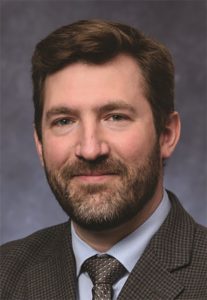 PROFESSOR JOHN KEITH
PROFESSOR JOHN KEITH
R.K. Mellon Faculty Fellow in Energy, Associate Professor, Department of Chemical and Petroleum Engineering, University of Pittsburgh, USA
FIELD OF RESEARCH: Computational Chemistry & Chemical Engineering
RESEARCH PROJECT: Using computational chemistry to simulate catalysts that could drive reactions for removal of carbon dioxide from the atmosphere.
FUNDER: National Science Foundation
This work is supported by the US National Science Foundation (CBET-1653392). Any opinions, findings, and conclusions or recommendations expressed in this material are those of the author(s) and do not necessarily reflect the views of the National Science Foundation.
ABOUT COMPUTATIONAL CHEMISTRY
Computational chemistry uses computer simulations to solve chemical problems. It involves incorporating theoretical chemistry methods into computer programs, which can then calculate the characteristics of molecules of interest. Dr John Keith explains more about his area of expertise.
WHAT DO YOU FIND MOST REWARDING ABOUT YOUR WORK?
I just love all the interesting information we can obtain simply by using a computer to watch and analyse simulations. I imagine it is like how ancient people felt when visiting an oracle. I get jazzed working with other scientists and engineers, getting our brains in sync to make a positive change in the world.
WHAT HAS LED YOU TO THIS POINT IN YOUR CAREER?
My current place is the result of many incremental steps. My undergraduate research project involved modelling gas phase chemical reactions, while for my Ph.D. I worked on modelling chemical reactions in solution. Since then, I modelled increasingly complex chemical reactions. Every experience added a new tool into what is now a big toolbox, and that enables me to analyse just about any kind of chemical reaction mechanism that comes my way.
WHAT OTHER AREAS OF RESEARCH HAVE YOU EXPLORED?
I’m extremely fortunate to get to study so many different and interesting topics. My group has received funding to study electrocatalysis for renewable chemicals, how to improve anticorrosion coatings, and how to make better consumer chemicals. Now, I’m working with colleagues to make better vaccines. This all works because my formal education was in physical chemistry, but I work alongside other chemists, physicists, mechanical engineers, materials scientists and medical researchers. Strong engineering programmes recognise that the most difficult problems need diverse thought to solve them, and so they form skilled teams within their departments and encourage inter-departmental collaborations.
WHAT CHALLENGES WILL THE NEXT GENERATION OF COMPUTATIONAL CHEMISTS FACE?
The field is evolving rapidly. Problems recently thought to be insurmountable, such as predictive models for protein folding, are now being solved using artificial intelligence and machine learning. Some are optimistic that quantum computers will allow computational chemistry to completely revolutionise the pace of scientific discovery. In the meantime, next-generation computational chemists should prepare to ride these waves by getting trained up and balancing the core maths and sciences with humanities, to ensure that these powerful tools are being used for good.
• Computational chemistry is sometimes offered as an advanced undergraduate physical chemistry course and, as John mentions, can be approached from a variety of directions, such as through studying chemistry and starting undergraduate research early. According to QS World University Rankings, the top universities for chemistry are MIT, Cambridge, UC Berkeley, Stanford, and Harvard. Many universities have experts in computational chemistry to learn from and John is proud to have studied at Caltech (the California Institute of Technology).
• Most opportunities to experience work in computational chemistry involve prior knowledge gained through undergraduate study or cooperative internships. For instance, pharmaceutical companies such as GlaxoSmithKline, AstraZeneca, and Merck offer computational chemistry placements for current undergraduates.
• According to PayScale, the average salary for a computational chemist in the US is $101.7k.
PATHWAY FROM SCHOOL TO COMPUTATIONAL CHEMISTRY
John recommends learning subjects like maths, statistics, physics, chemistry, computer science and programming. He also says these should be taken alongside social sciences and humanities for a well-balanced education.
At university, John says that maths is extremely important for computational chemistry, especially calculus, differential equations and linear algebra. Maths, in addition to studying or researching chemistry, biology, materials science or chemical engineering, helps round out the necessary skillset.
John emphasises that computational chemistry is evolving fast – discrete maths, probability, data science, machine learning, artificial intelligence and new computing architectures are all becoming increasingly prominent. He believes that quantum computing may also revolutionise the field in future decades.
HOW DID JOHN BECOME A COMPUTATIONAL CHEMIST?
WHAT WERE YOUR INTERESTS AS A CHILD?
I went through phases of being obsessed with video games and sports (with little success), but my most major investments as a child were in schoolwork and music lessons. I am a classically trained cellist from a musical family, and I still try to play whenever I can. Music led to great friendships, and I have no regrets.
WHO INSPIRED YOU TO BECOME A SCIENTIST?
My maternal grandfather was a refugee from the Russian revolution of 1917. His version of the American dream involved him becoming a ballistics engineer for the US Army. His daughters and grandchildren all entered the sciences, so I am continuing a family tradition. Personally, I was helped by great teachers at school in central Minnesota and my undergraduate liberal arts college. My undergraduate research mentor taught me that quantum mechanics can answer many interesting scientific problems, and I never looked back after that.
WHAT ATTRIBUTES MAKE YOU A SUCCESSFUL SCIENTIST?
I have decent organisation, time-management and academic background, but my strongest attribute is probably my tenacity – I don’t give up on an important problem and can approach obstacles from different angles. It helps to have friends and colleagues in different areas to discuss ideas with and learn from. In the end, like any skill, what one needs will improve with time and practice. Weaknesses should be strengthened, but the pursuit of perfection should not stop progress.
HOW DO YOU OVERCOME OBSTACLES IN YOUR WORK?
It’s a gradual process. I will contemplate an obstacle for hours to weeks at a time and wait for inspiration to strike! I’ll then bounce ideas off family, friends and colleagues for outside perspectives. It’s critical to make theories understandable to non-experts. I then try to carve out time to dig into the details with books and literature and woodshed the theory until I hit another wall – and then I repeat the process.
WHAT ARE YOUR AMBITIONS FOR THE FUTURE?
I want to keep doing cutting-edge research, make education better and more equitable, help train a diverse scientific workforce, and undertake meaningful service projects for my community. My job as a professor gives me a lot of flexibility. For next year, I am contemplating how to disrupt the norms of computational catalysis design; how to launch an educational bridge programme to bring diversity into chemical engineering graduate programmes; and I might be able to launch a start-up company for designing environmentally friendly chemicals. I also aspire to be a good husband and dad.
JOHN’S TOP TIPS FOR STUDENTS
01 Focus on finding mentors you can question and learn from daily. They may open new doors that you didn’t even know existed.
02 Never be afraid to ask questions, but never rely on one opinion or answer alone.
03 Any craft requires time and dedication, but don’t forget your family, friends, and hobbies.
Write it in the comments box below and John will get back to you. (Remember, researchers are very busy people, so you may have to wait a few days.)


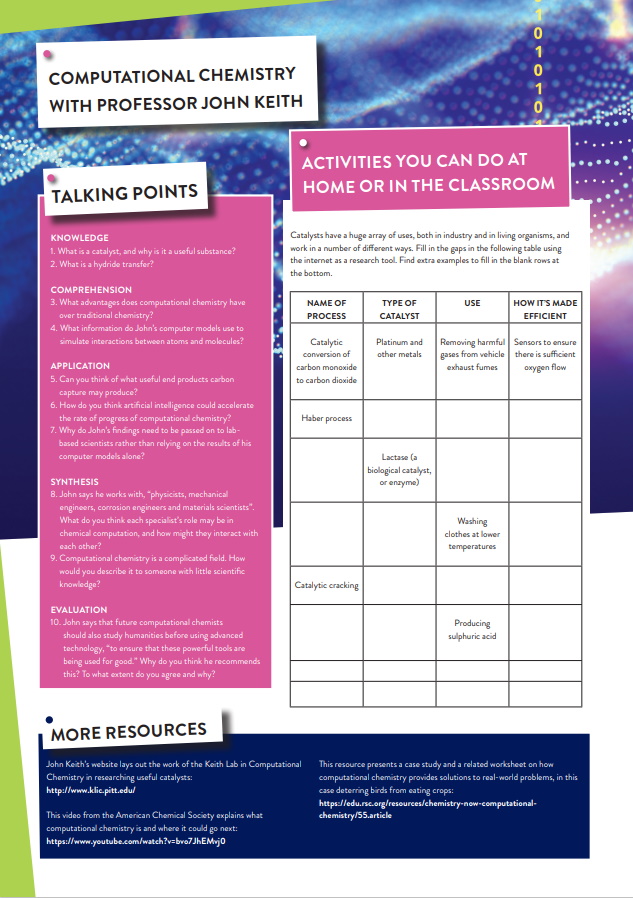




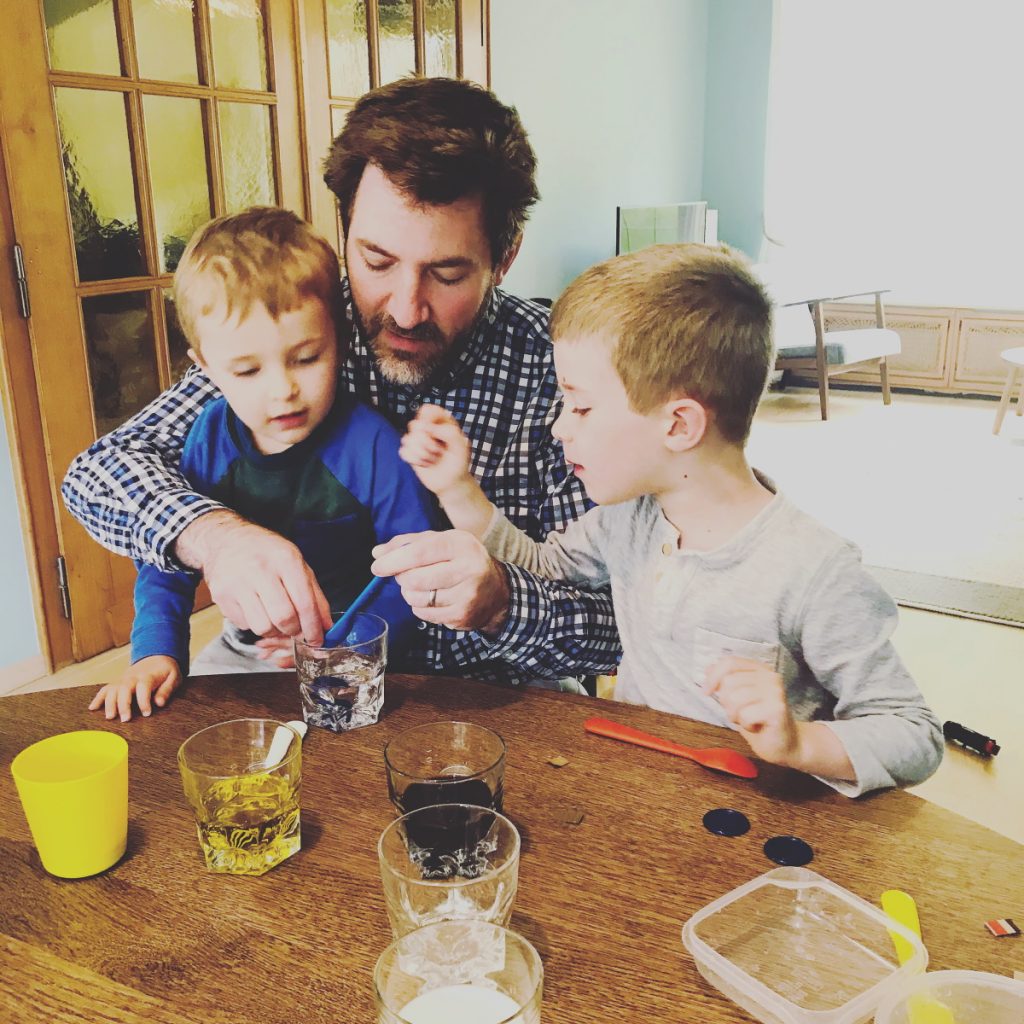
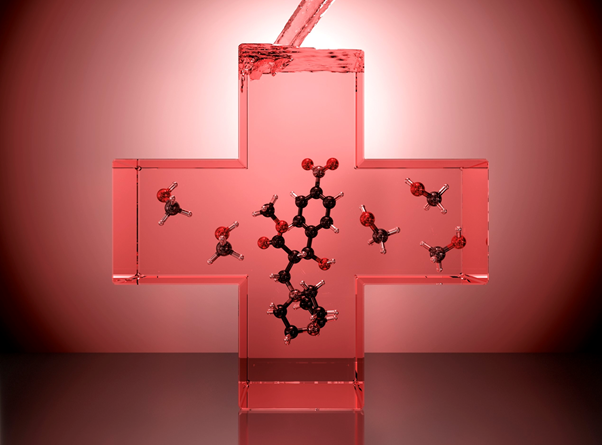
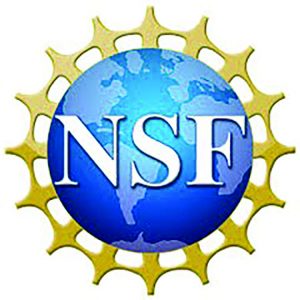

What are the right resources required to carry out research in computational catalysis?
Great work Prof. John. I have come across your article while researching about How Comoutational Chemistry can be used to curb adverse climate change, and i am fired up now.
I am planning to start my Postgraduate Degree in Atmosphetric Computational Chemistry this year. Could you be seeking PhD/ Master’s students for your projects on the same? If yes, kindly let us talk more on email. My undergradute background is in Industrial Chemistry.